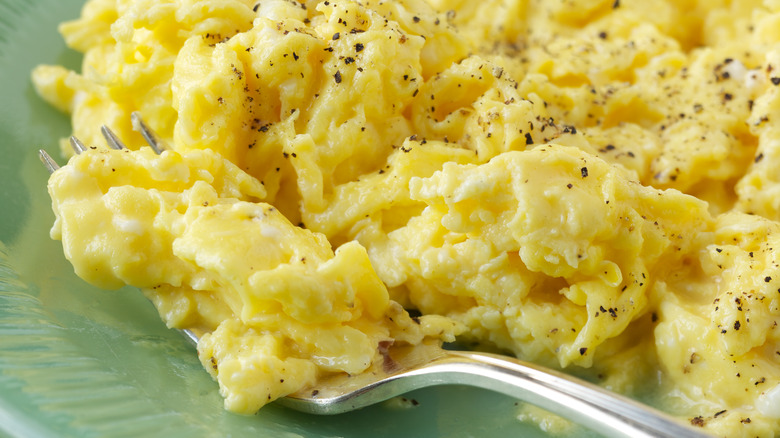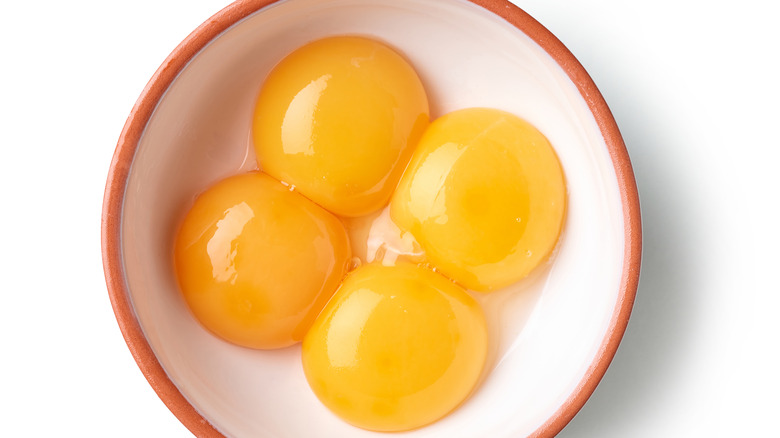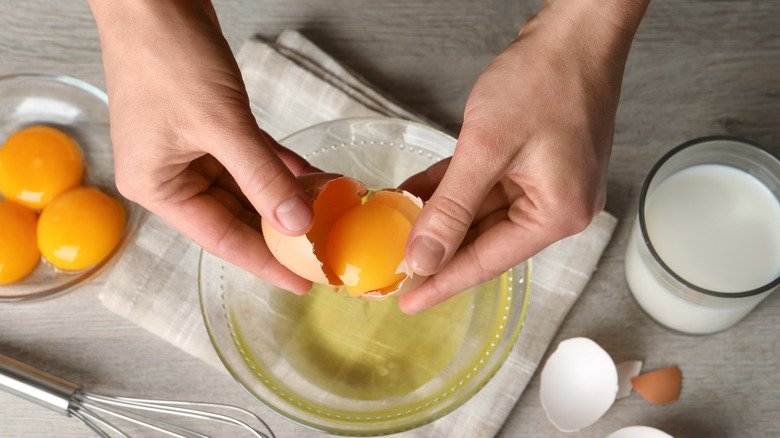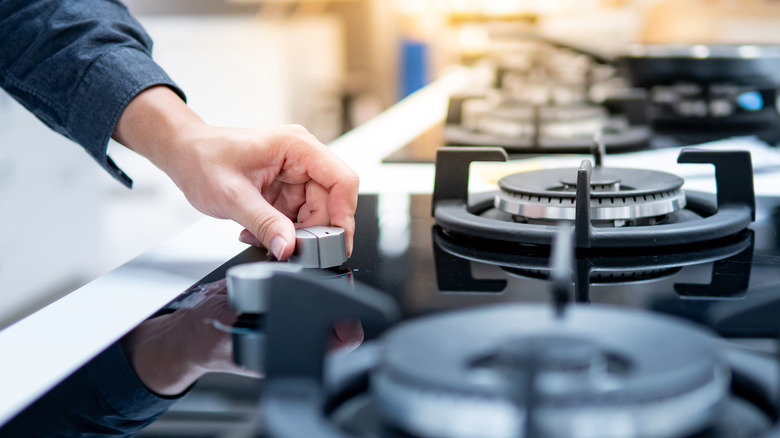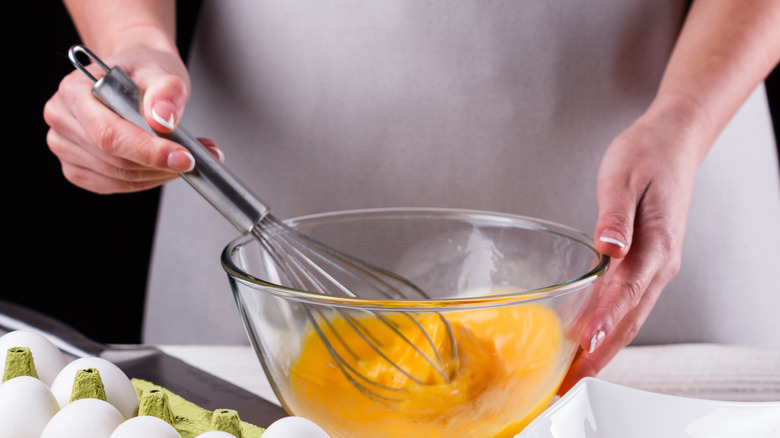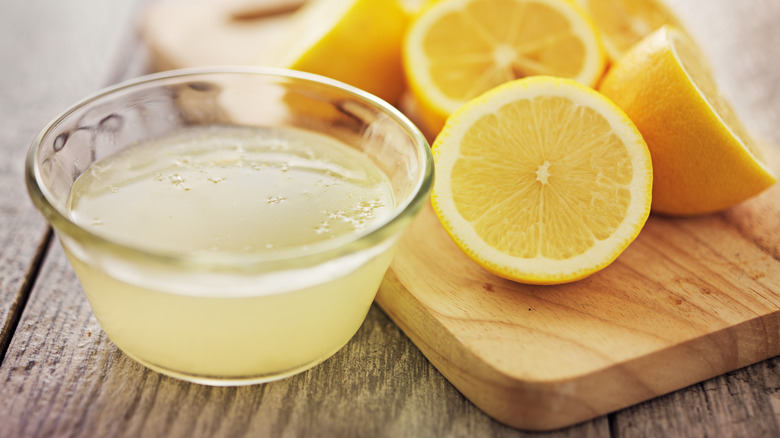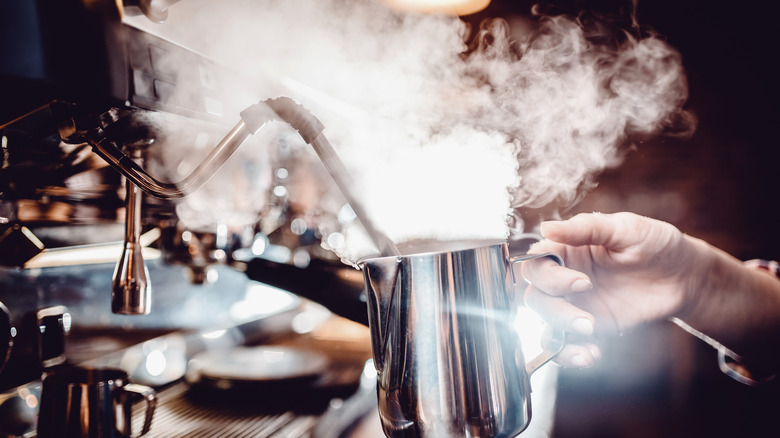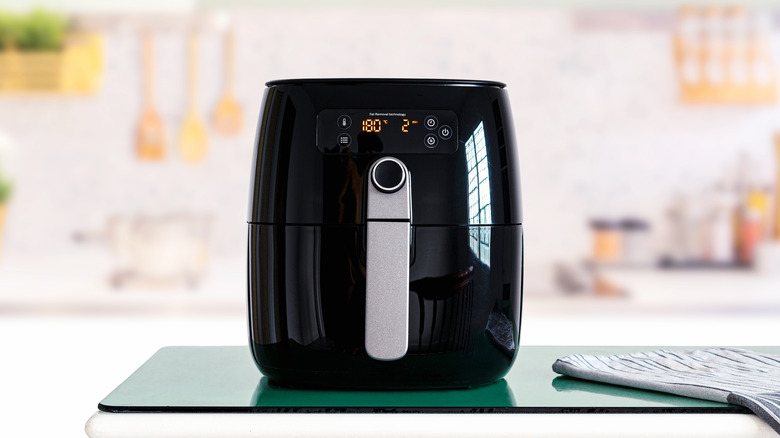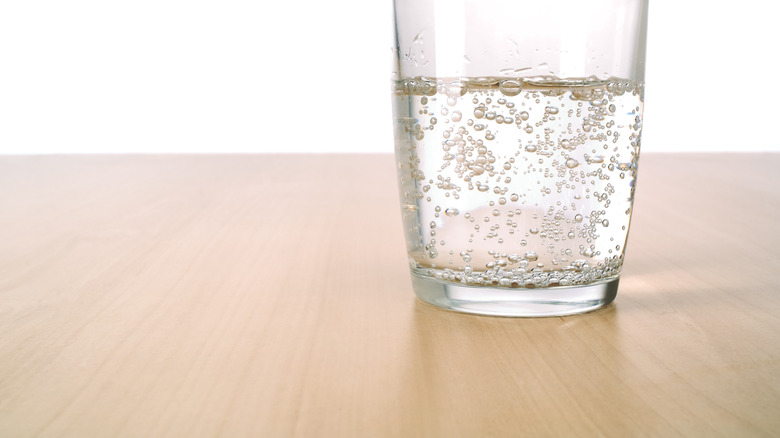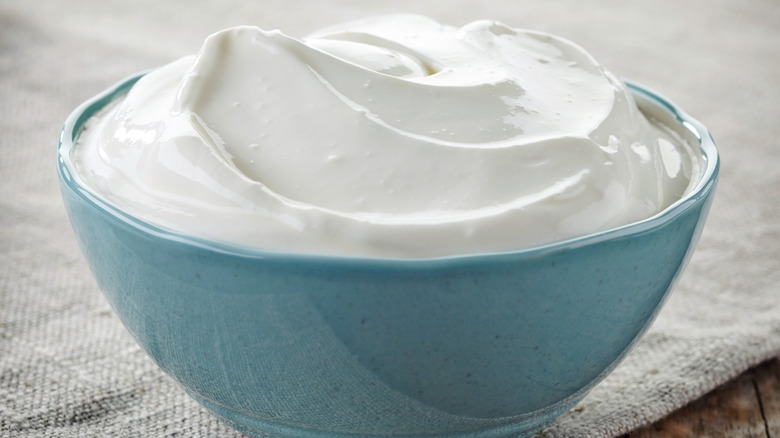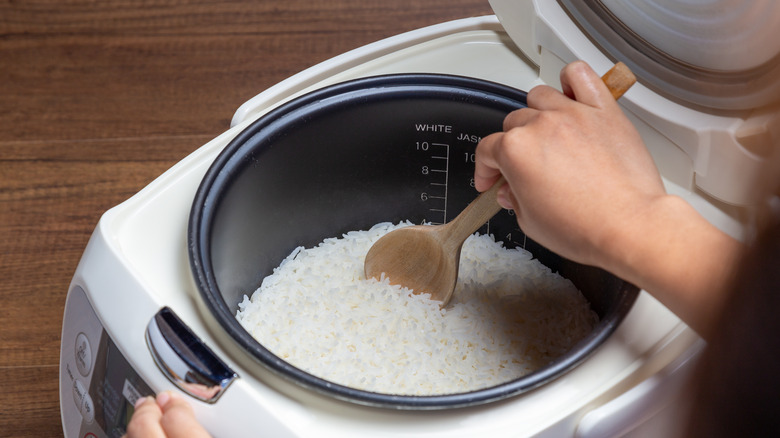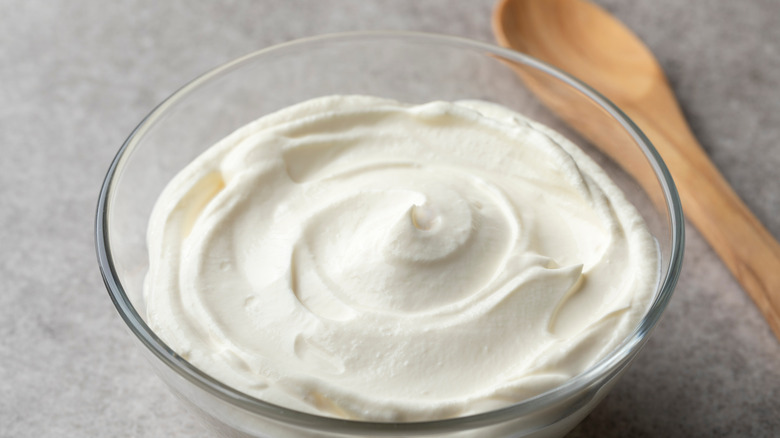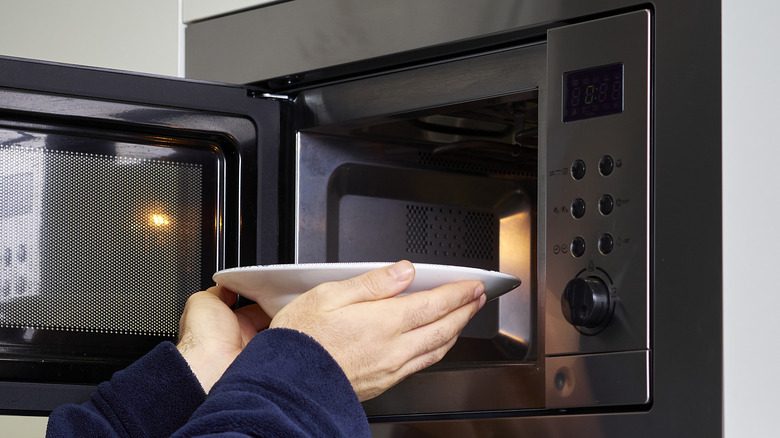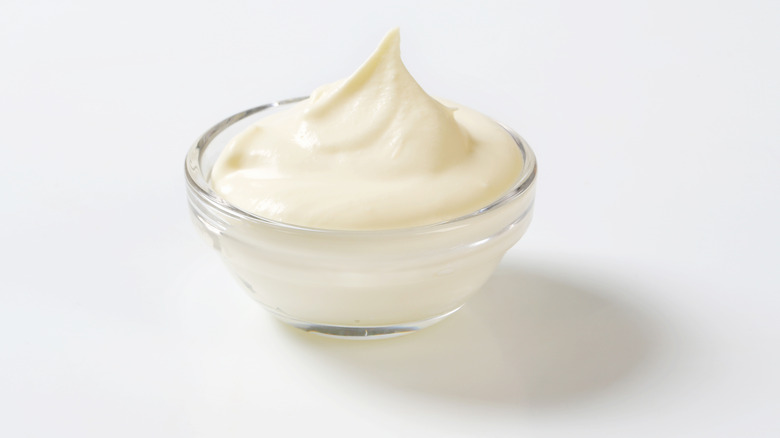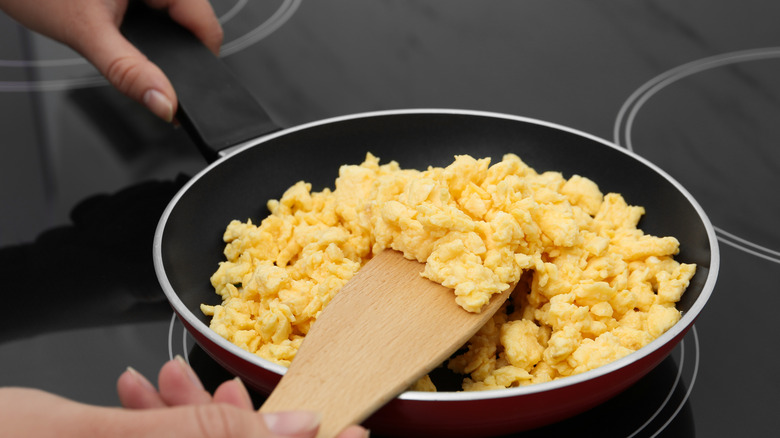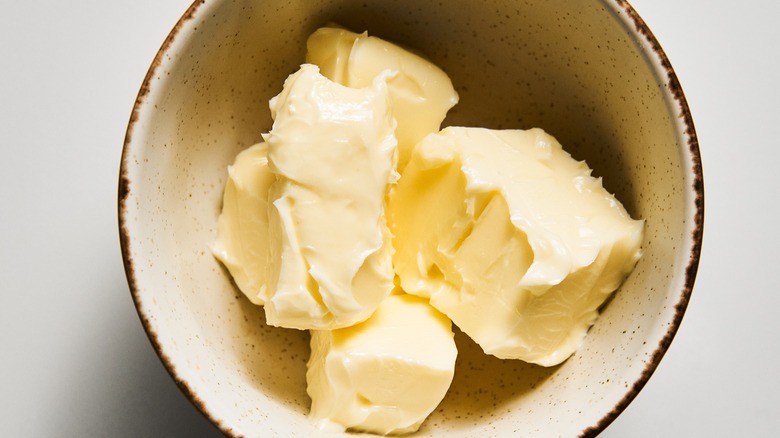16 Tips For The Fluffiest Scrambled Eggs
No breakfast is complete without scrambled eggs. Our exclusive survey revealed that 45% of the 17,000 individuals surveyed would choose scrambled eggs as their favorite style over poached, fried, hard-boiled, and sunny side up. Simply put, it's hard to say no to a delicious, warm, and fluffy plate of eggs seasoned simply with salt and pepper.
Scrambled eggs are significantly less appealing, however, when dry and overcooked. In order to sidestep such a cooking catastrophe, you have to understand how and why eggs cook the way they do, and how small ingredient additions, changes in cooking methods, or even investing in an appliance other than a stovetop may help make them delectable, not detestable. Below are some of the best tips for preparing eggs that are perfectly fluffy every time and ready to be devoured, whether on top of toast, inside a breakfast sandwich, or alongside other breakfast favorites.
Add in extra egg yolks
When most people make scrambled eggs, it's a matter of cracking the eggs into the bowl and mixing. But if you want the softest scrambled eggs, you should consider altering your ratio of yolk to white. Adding more egg yolks will take scrambled eggs to the next level, because the added fat and subsequent emulsification raises the temperature that the egg proteins require to bond. This higher temperature requirement means the eggs are less likely to be overcooked, thereby almost guaranteeing they remain in a soft state.
Keep in mind, you don't need to go crazy with adding extra yolks to a recipe. For every four eggs, just add a single extra yolk. If you're looking for something to do with the extra egg whites, consider whipping up a meringue dessert, adding them to a baked good, or saving them for your next egg white omelet.
Skip adding milk
It's anybody's guess who originally had the bright idea of adding milk to scrambled eggs, but they likely didn't understand the science behind why this hack doesn't work. You should think twice about putting milk in scrambled eggs because that cow juice only serves to dilute the sublime eggy flavor of the dish, making it more difficult to cook perfectly. This is because milk makes the scrambled egg mixture thinner, which causes it to cook faster. If you add milk to eggs, expect the resulting consistency to be drier than if the milk had been skipped.
Instead, consider adding a different dairy product: butter. The fat in a stick of butter alters the protein in the eggs, keeping them from coagulating. As an added bonus, it imparts that delectable, rich buttery flavor that can make scrambled eggs soar; pair them with a toasted bagel, and it's the perfect way to start a day.
Pour in a small amount of water
Some people will insist on adding some sort of liquid to their eggs. If milk dries out the curds and causes a crumbly mess rather than a fluffy, soft texture, the next best bet is adding water. The water will steam the eggs in the pan, which helps keep the moisture and soft consistency.
But be sure to exercise some restraint when adding water to an egg mixture. All that is required is about half a teaspoon of water for each egg, so avoid adding more than two teaspoons total. Too much water, and the pan could potentially flood, diluting the eggs too much, which will only result in the same situation as adding milk to the eggs. In addition, it's essential to be patient and cook the eggs over medium-high heat until the water steams and cooks the eggs. Trust the process, and the reward with be professional-level fluffy eggs.
Keep the heat on low
It always feels like turning the dial on a stove to the perfect temperature is a bit arbitrary. What is the proper way to decide how hot to set a stove, and when is the right time to add eggs to the pan?
One of the best tips for cooking softer scrambled eggs is to avoid setting the heat too high. When the eggs hit a hot pan, the proteins in the egg can coagulate and form the curds rather quickly. Instead, setting the stove on medium-low will ensure maximum control over the cooking time of the eggs and will force them to retain their moisture for longer.
A good way to determine when a pan is ready for eggs is to examine the color of the butter. If the butter has browned, the temperature of the pan is too high. It's also important to remember that a pan holds heat, so shut off the heat from the stove once the eggs have formed consistent, soft curds at around the ten-minute mark. Allow those eggs to cook for about thirty more seconds in the pan, off direct heat, and then serve.
Whisk eggs before adding them to the pan
There will always be those who throw caution to the wind, and one thing they might do is dump their eggs into a pan without first properly scrambling them. Although it might seem like a minor, inconsequential step in the scrambled egg process (after all, they'll just scramble in the pan anyway), it is one that should not be skipped.
This crucial step is vital because whisking the eggs breaks up the egg white proteins. A looser structure for the whites means that air bubbles will get trapped inside, which results in a plusher plate of scrambled eggs. Equally as crucial as whisking the eggs before adding them to the pan is what is used to beat them. A wire beater tends to add too much air to the mixture; a standard kitchen fork works much better. The texture will be perfectly fluffy, and the end result sublime.
Add a bit of lemon juice to keep the mixture light
An acidic ingredient isn't often considered when making standard scrambled eggs — but it should be. Lemon juice can elevate scrambled eggs because the acid fundamentally changes the egg whites' protein structure as it's whisked. This allows the egg mixture to better hold air, creating a fluffy plate of scrambled eggs. In addition, the acid will denature some of the proteins, keeping the curds soft and preventing them from getting overcooked so easily. As the lemon juice cooks, it will release steam and cook the eggs around it, too.
Besides the functional purpose of the lemon juice, adding it to eggs will spark a tangy, bright flavor contrast that helps awaken tastebuds with every bite. Only about a half-teaspoon of juice is required for every two to three eggs; add a smidge more if you want the flavor to carry more potency.
Turn to a cappuccino machine
Fans of kitchen gadgets might look around the room and wonder which could potentially help step up scrambled eggs. Martha Stewart's recommendation might be a little unconventional, but it produces great results.
The unlikely appliance Martha Stewart uses for her fluffy scrambled eggs is a cappuccino maker. The entertainment mogul turns to this appliance, of all things, because the frother steams the eggs, thereby reducing the opportunity for them to become tragically overcooked. As she demonstrated on the set of "Chopped," Stewart cracks her eggs into a clear coffee cup with salt, pepper, and butter. Then, she turns on the steam wand and gently froths the eggs until they're cooked to her liking. If you take this tip out of her culinary playbook, be sure to give that wand a deep clean afterwards; after all, nobody likes eggs floating around inside their cappuccino.
Cook the eggs in an air fryer rather than the stove
An air fryer can apparently cook anything. Yes, even eggs.
Fluffy scrambled eggs are easier to make in an air fryer than on a stovetop. Start by preheating the air-fryer to 220 F before adding the fat to a small, heat-safe pan like a ceramic ramekin. It's essential to nestle the pan into the basket of the air fryer rather than just pouring the eggs into it. Use a non-stick vessel, since it will make the scrambling step easier.
Once the air fryer is sufficiently heated, add seasoned, pre-whisked eggs. Set the eggs in the air fryer for two minutes before stirring them and cooking again until they reach the desired level of doneness. Avoid altering the temperature to cook the eggs faster; like on a stovetop, go low and slow to keep them fluffy and moist. Don't neglect the stirring either, as it will prevent some of the eggs from cooking faster than the rest.
Keep things soft with seltzer water
Lots of people love the effervescent experience of cold seltzer. Not only can the beverage be delicious to drink on a hot summer day, but surprisingly, it can also serve as the key to getting fluffy eggs without much effort. Try adding seltzer water to scrambled eggs, because the air bubbles create air pockets that expand when exposed to heat.
Add one tablespoon of seltzer water for every two eggs in the recipe. Be sure to stick to this ratio, as adding too much liquid (in the form of seltzer water, milk, or plain water) will make eggs runny. Although the water won't impact the taste of the eggs, plain seltzer is best — don't go experimenting with cranberry lime or black cherry flavor. Cloud-like, fluffy eggs are only a can away — and be sure to reserve the rest for sipping or adding to a mimosa mocktail.
For fluffy eggs, turn to sour cream
When making delicious scrambled eggs, fat is a friend. Tis is why sour cream is ideal for enhancing the flavor of a recipe. Paula Deen's scrambled eggs call for four teaspoons of sour cream per four eggs. The Southern cooking figure adds the creamy dairy product to her eggs with salt, pepper, and a splash of water, then whisks them all together before pouring into a hot pan to cook. The resulting plate of eggs is somewhat wet and soft, but nevertheless creamy and fluffy.
Another ingredient Deen adds to boost the flavor of scrambled eggs is bacon grease. She adds equal parts of the leftover ingredient with another one of her favorites, butter, to the pan before her egg mixture. Not only is this a creative way to use up grease that would otherwise end up in the trash, but it also adds a lot of breakfast flavor to eggs.
Try cooking scrambled eggs in a rice cooker
While most people only use a rice cooker to prepare brown, Jasmine, or white rice, those in the know are aware that the appliance is also an ideal way to make delicious scrambled eggs without a stove. To use this versatile kitchen gadget, start by whisking eggs with a desired seasoning and a little splash of water. Then, grease that rice cooker with non-stick cooking spray or the fat of choice. Then, put the machine on the "cook" setting and close it.
Just because this appliance is relatively hands-off, however, it doesn't mean those eggs can be neglected. Cook the eggs for two to three minutes before popping the lid and stirring them well. But be careful to avoid cranking that heat up too high, as this will cause the eggs to dry out and be as unsuccessful as any stovetop mishap.
Add a scoop of crème fraîche
We've learned a lot about cooking from the French, and in modern times Americans have learned plenty from chef and entertainment icon Gordon Ramsay. His scrambled egg recipe has been cited as one of the creamiest and fluffiest ones out there, thanks to an ingredient common in French-style scrambled eggs but less commonly used on these shores.
Ramsay adds crème fraîche to his eggs for a fluffy texture. Unlike other chefs who add creamy ingredients to the eggs in the beginning, Ramsay reserves the crème fraîche for after his eggs are finished cooking, imbuing them with a bright, creamy finish to the eggs.
His eggs aren't just about what he adds to them, but also his methodology for cooking. Ramsay always adds the seasoning, which includes salt, paprika, pepper, onion powder, and chili pepper, to the eggs. This is because the salt tends to dry out the eggs as they cook, rendering them rubbery. He also constantly moves the eggs on and off the heat as they cook, preventing overcooking due to prolonged heat exposure.
Serve the eggs on a pre-heated plate
After going through all the trials and tribulations of making the perfect scrambled eggs, don't drop the ball in the home stretch. Alton Brown's secret to better scrambled eggs doesn't even have anything to do with ingredients or preparation; always serve eggs on a warm plate rather than a cold one, which will suck warmth out of the eggs and make them taste drier.
There are numerous ways to heat up a plate. Perhaps the best is to simply put a plate in the microwave for a minute or two; just be sure to grab it with a kitchen towel or oven mitt to prevent scalding. Cooking breakfast for a crowd? Put some plates in the oven instead. Another good idea is to run the plates through the dishwasher right before serving, or even submerge them in a tray of warm water (and then dry them off) before piling on the breakfast.
Grab a jar of mayo
Mayonnaise is a condiment that may forever change how you make scrambled eggs. It's an unexpected ingredient that Alton Brown puts in his scrambled eggs, keeping them soft and fluffy. Although the condiment is typically employed in creamy potato salads or schmearing on top of a burger, adding it to eggs will boost the fat content and give that breakfast a creamier mouthfeel.
Although mayonnaise may seem like a strange condiment to add to eggs, think of it as a sum of its parts. It's made from eggs, as well oil and acid — all ingredients that help prevent the protein structures in the egg from getting too tight and causing it to come out rubbery. Brown adds a teaspoon of mayonnaise with equal parts water to his scramble before putting it into the pan. The emulsion takes eggs to a new level, even if it might feel a bit odd.
Stir the eggs constantly to prevent them from hardening
No matter how many strange ingredients are added to scrambled eggs, if the cooking method isn't spot-on, it won't result in perfect, fluffy scrambled eggs. The secret to avoiding flat scrambled eggs, more than anything, is in how they are prepared.
Push the eggs from the outside of the pan towards the center as they're cooking, and only stop when there isn't any liquid remaining in the pan. Once this occurs, immediately remove the eggs from the pan and transfer them to a plate. This is because leaving the eggs in a hot pan, even without direct heat exposure, can cause them to overcook.
For soft and fluffy scrambled eggs, use a pan with a wide base and short sides to keep the heat well-distributed across the egg mixture. When stirring, try to use big sweeping motions to keep the curds large — which will, in turn, lock in the moisture.
Dice up butter for pockets of creaminess
Chef and food columnist J. Kenji López-Alt knows a lot about cooking, so it's no surprise he has some advice for making the perfect scrambled eggs at home. He combines two ingredients for creamy scrambled eggs: corn starch and cubed butter. López-Alt mixes his eggs with a milk-and-corn-starch slurry to prevent any wateriness from the eggs and to thicken the mixture before it hits the heat. Some variations of this hack will use potato starch instead, but corn starch is a more ubiquitous ingredient in home kitchens.
The chef also cubes up cold butter into small pieces and mixes it into the eggs. As he explained in a 2021 YouTube video, the cold butter creates localizes pockets of creaminess and coldness that make a delicious textural contrast in the final dish. Cube the butter first, toss it in the freezer to harden, then add it to a scramble. Your soft, fluffy eggs will thank you.
Static Media owns and operates Tasting Table and Mashed.
